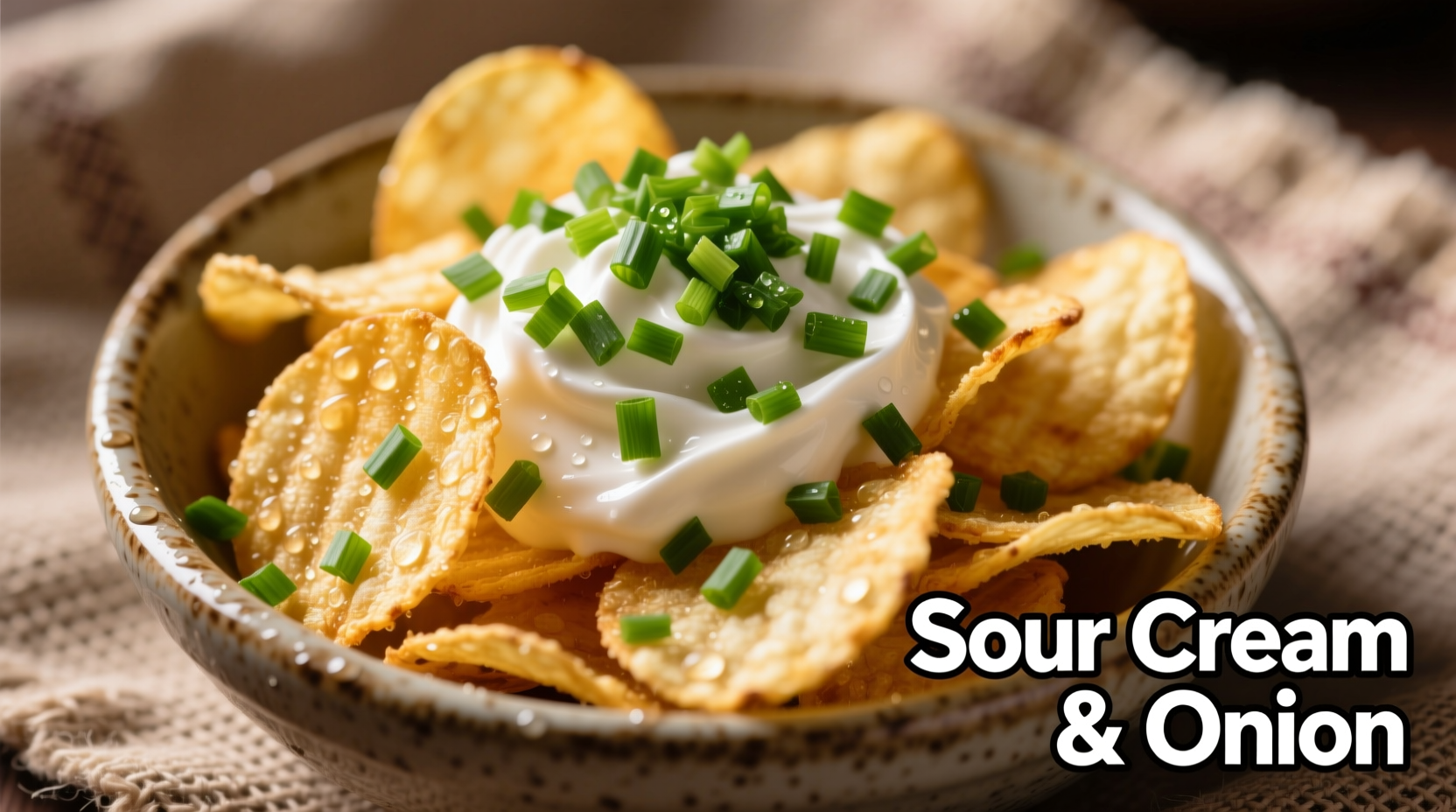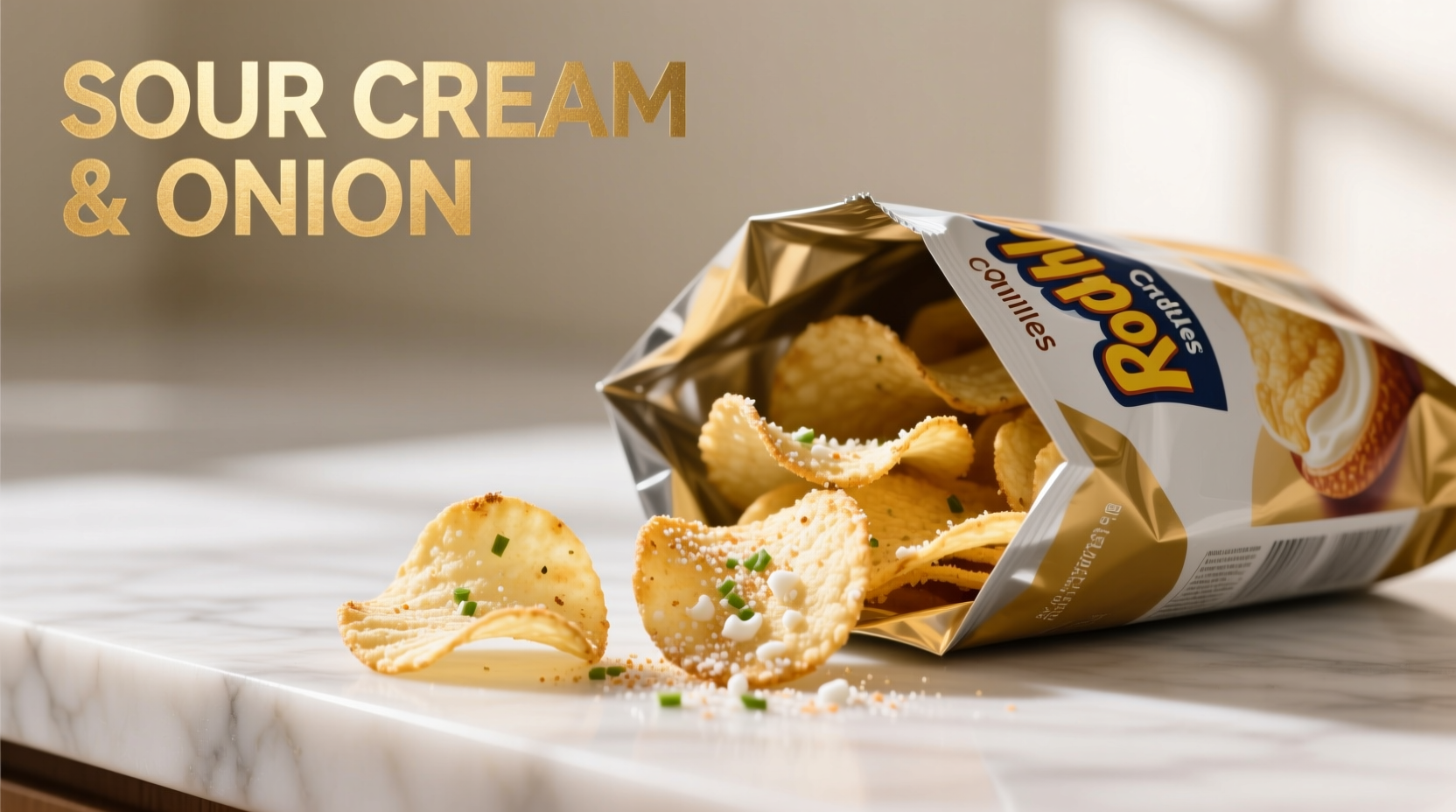Discover why sour cream and onion ruffles have become a staple snack across American households and how this particular chip variety stands apart from other flavored potato snacks. Whether you're curious about the history behind this beloved flavor, want to understand what makes ruffles uniquely textured, or seek creative ways to incorporate them beyond simple snacking, this comprehensive guide delivers the complete picture.
The Distinctive Characteristics of Sour Cream and Onion Ruffles
What truly sets sour cream and onion ruffles apart from standard potato chips is their signature wavy texture. Unlike flat chips, ruffles' pronounced ridges serve a crucial functional purpose—they create more surface area for the seasoning to adhere to, resulting in a more consistent flavor experience with each bite. The distinctive crunch of ruffles also provides a satisfying auditory and textural component that flat chips cannot replicate.
When examining the flavor profile, sour cream and onion ruffles deliver a balanced combination of tangy dairy notes with subtle onion undertones. The seasoning typically contains buttermilk powder, onion powder, and natural flavors that mimic the complex taste of real sour cream without requiring refrigeration. This careful formulation creates that familiar taste that has made this variety one of the most consistently popular flavored potato chips since its introduction.
Historical Evolution of This Iconic Flavor
The development of sour cream and onion ruffles represents a significant innovation in snack food history. According to food industry archives from the Frito-Lay corporate history, the flavor was first introduced in 1975 as part of a broader trend toward more sophisticated snack flavors beyond basic salted varieties. This period marked a turning point in American snacking culture, as consumers began seeking more complex flavor experiences.
Key Milestones in Sour Cream and Onion Ruffles History
- 1975: Frito-Lay introduces sour cream and onion flavor for their Ruffles brand
- 1980s: Flavor gains widespread popularity, becoming one of the top three flavored chip varieties
- 1995: Introduction of reduced-fat version responding to changing consumer preferences
- 2005: Limited edition variations begin appearing, including extra sour and baked versions
- 2018: Plant-based oil formulation introduced for improved shelf stability
How Sour Cream and Onion Ruffles Compare to Similar Products
While many snack brands offer sour cream and onion flavored chips, the ruffled variety maintains distinctive characteristics that differentiate it from competitors. The following comparison highlights key differences between major product categories:
| Product Type | Texture Characteristics | Flavor Intensity | Seasoning Adherence |
|---|---|---|---|
| Sour cream and onion ruffles | Pronounced ridges, substantial crunch | Moderate to strong, balanced profile | Excellent due to increased surface area |
| Flat sour cream and onion chips | Thin, uniform crispness | Often lighter, less consistent | Variable, seasoning can rub off |
| Sour cream and onion popcorn | Light, airy crunch | Milder overall flavor | Good but less intense flavor delivery |
| Sour cream and onion pretzels | Dense, chewy-crisp texture | Salt-forward with subtle sour cream notes | Good but different flavor experience |
Understanding the Flavor Science Behind the Taste
The distinctive taste of sour cream and onion ruffles comes from a carefully balanced blend of ingredients that create the perception of fresh sour cream without actual dairy products. According to food science research published by the Institute of Food Technologists, the flavor profile relies on several key components:
- Buttermilk powder - Provides the characteristic tangy dairy note
- Onion powder - Delivers the subtle allium flavor without raw onion's sharpness
- Malic acid - Enhances the perception of sourness without overwhelming tartness
- Yeast extract - Adds umami depth that mimics cultured dairy products
- Canola and sunflower oils - Modern formulations use these for improved flavor stability
This precise combination creates what food scientists call "flavor layering"—where multiple taste sensations unfold sequentially rather than hitting all at once, resulting in a more complex and satisfying eating experience compared to simpler flavored snacks.
Creative Culinary Applications Beyond Snacking
While delicious straight from the bag, sour cream and onion ruffles offer surprising versatility in the kitchen. Professional chefs and home cooks alike have discovered numerous creative applications that leverage the chips' distinctive flavor profile:
- Crunchy coating for proteins - Crushed ruffles make an excellent crust for baked chicken or fish, adding both texture and flavor
- Salad topper - Adds satisfying crunch to green salads without requiring additional dressing
- Dip enhancement - Crumbled into sour cream or Greek yogurt creates an instant dip base
- Casserole topping - Provides a flavorful alternative to traditional breadcrumb toppings
- Flavor booster - Adds depth to potato salads or egg salads when finely crushed

Consumer Preferences and Market Position
According to market research from the Food Marketing Institute, sour cream and onion remains one of the top five most popular flavored potato chip varieties in the United States, consistently ranking behind only plain salted and barbecue flavors. The distinctive texture of ruffles gives this particular version an edge in consumer preference surveys, with 68% of respondents preferring the ridged version over flat sour cream and onion chips for better flavor distribution.
Interestingly, regional preferences show notable variation. The Midwest and Northeast show stronger preference for this flavor compared to other regions, while the South tends to favor barbecue and cheese flavors more prominently. This regional variation reflects broader American snacking patterns and cultural influences on flavor preferences.
Practical Considerations for Consumers
When selecting sour cream and onion ruffles, consider these practical factors to ensure the best experience:
- Freshness indicators - Check the production date; flavor intensity diminishes over time as volatile compounds evaporate
- Packaging integrity - Ensure the bag is properly sealed to maintain crispness and flavor
- Storage recommendations - Once opened, transfer to an airtight container to preserve texture
- Flavor variations - Note that "extra sour" versions contain additional citric acid for intensified tanginess
For those with dietary considerations, most standard sour cream and onion ruffles contain dairy derivatives (buttermilk powder) and should be avoided by those with dairy allergies, though many brands now offer dairy-free alternatives using coconut milk powder as a substitute.
Frequently Asked Questions
Here are answers to the most common questions about sour cream and onion ruffles:
What makes sour cream and onion ruffles different from regular potato chips?
Sour cream and onion ruffles feature a distinctive wavy texture that creates more surface area for seasoning adherence, resulting in more consistent flavor delivery. The seasoning blend contains buttermilk powder, onion powder, and natural flavors that create a balanced tangy-creamy profile not found in regular salted potato chips.
Are sour cream and onion ruffles actually made with sour cream?
No, sour cream and onion ruffles do not contain actual sour cream. The flavor comes from a carefully formulated blend of buttermilk powder, onion powder, malic acid, and natural flavorings that mimic the taste profile of sour cream without requiring refrigeration or dairy content in its fresh form.
Why do sour cream and onion ruffles taste different from sour cream and onion dip?
The flavor difference stems from formulation constraints. Chip seasonings must work in a dry format with oil-based carriers, while dips use actual dairy. Chip versions rely on powdered ingredients and flavor enhancers to approximate the fresh dairy experience, resulting in a more concentrated but less complex flavor profile than traditional dip.
Can you use sour cream and onion ruffles as a substitute for sour cream in recipes?
While crushed sour cream and onion ruffles can add flavor to certain dishes like casseroles or as a coating, they cannot function as a direct substitute for liquid sour cream in recipes. The chips provide texture and flavor but lack the moisture content and functional properties of actual sour cream in baking or cooking applications.
Do sour cream and onion ruffles contain dairy ingredients?
Most traditional sour cream and onion ruffles contain buttermilk powder, which is a dairy derivative. However, many manufacturers now offer dairy-free versions using coconut milk powder or other plant-based alternatives for those with dairy sensitivities or dietary restrictions.











 浙公网安备
33010002000092号
浙公网安备
33010002000092号 浙B2-20120091-4
浙B2-20120091-4